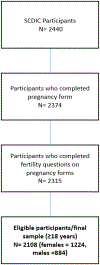Infertility and treatment-seeking practices among females and males with sickle cell disease in the Sickle Cell Disease Implementation Consortium registry
- PMID: 37057750
- PMCID: PMC10361249
- DOI: 10.1002/pbc.30356
Infertility and treatment-seeking practices among females and males with sickle cell disease in the Sickle Cell Disease Implementation Consortium registry
Abstract
Objective: To describe the prevalence of infertility and infertility treatment seeking among people enrolled in the Sickle Cell Disease Implementation Consortium (SCDIC) registry and identify sociodemographic and clinical correlates of infertility.
Design: Cross-sectional.
Participants: The study population included 2108 women and men (≥18 years of age) enrolled in the SCDIC registry who completed the fertility questionnaire.
Results: All participants who completed the infertility-specific questions were included in the analysis (1224 females; 884 males). Of these, 16.9% of males and 23.7% of females reported infertility, in contrast to rates in the general population (12% of males; 11% of females). Only 22.8% of this subgroup had sought a fertility consultation; of these, 41% received infertility testing and 58% received advice, yet only a few received specific treatment: ovulation medication (19.1%), fallopian tubal surgery (4.8%), other female treatment (17.5%), varicocelectomy (8.1%), or other male treatment (10.8%). Increasing age, employment status, and interaction between gender and single marital status are associated with reported infertility. We did not observe differences between groups relative to sickle cell disease (SCD) genotype, a broad category of self-reported hydroxyurea use any time during life, type of medical insurance, income, or education.
Conclusion: To our knowledge, this is the first study to examine self-reported identification of and treatment for infertility among a large sample of people with SCD. These findings suggest that (a) infertility occurs at a higher rate, but fertility care treatment seeking is less frequent than in the general public; and (b) sociodemographic and clinical differences between individuals who report experiencing infertility and those who do not did not emerge in this study.
Keywords: female infertility; infertility treatment; male infertility; sickle cell disease.
© 2023 Wiley Periodicals LLC.
Conflict of interest statement
Conflict of Interest Disclosure Statement:
Eleanor Stevenson: none
Paula Tanabe: Consultant: CSL Behring
Mitchell Knisely: none
Rita Masese: none
Dominique Bulgin: Consultant for RTI International, PhenX Toolkit
Liliana Preiss: none
Jane S. Hankins: none
Allison A. King: none
Victor Gordeuk: none
Nirmish Shah: Research: GBT; Consultation: GBT, Novartis, Emmaus Pharmaceuticals, Agios; Speaker: GBT, Novartis, Emaus Pharmaceuticals, Alexion.
Figures
References
Publication types
MeSH terms
Grants and funding
LinkOut - more resources
Full Text Sources
Medical



